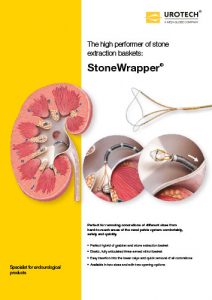34th EAU Congress, March 2019 – COMPANY HIGHLIGHTS
Urovision-Urotech, member of the Medi-Globe Group, took the opportunity to launch the innovative StoneWrapper® and present the new Group CI at the world’s third largest urology congress. Our appearance attracted many international visitors: our motto at the booth: “Stars created for comfort”.

Especially the Magnetic Black-Star and the innovative Stone Wrapper were of great interest: The high level of comfort resulting from the simple removal of the magnetic stent is convincing in the clinic – as is the new design and flexibility offered by the StoneWrapper®.
Meet our Stars:
CONGRESS SUMMARY
Visitors were once again able to find out about the latest research findings and trends in exciting symposia and digital sessions. We have summarised some impressive results of the extensive know-how transfer from the entire spectrum of urology. We refer in particular to the Uro congress X-press run by the MedMedia publishing house (Vienna), which offers an extensive overview every year.
Botulinum toxin type A in chronic prostatitis/chronic pelvic pain
In a study by Khelaia et al. (Tbilisi, Georgia) the results of botulinum toxin type A (Xeomin) in young men with chronic prostatitis / chronic pelvic pain (CP/CPPS) were presented. A total of 28 patients with an average age of 32.8 years were given 300 IU (100 IU in each prostate lobe and 100 IU in the perineal area). The NIH-CPSI score improved from 23.45 to 15.43 after 3 months. Pain during DRU improved from VAS 8.65 to 3.41 after 3 months. Dysuria improved in 72% and painful ejaculation in 86%. Although this administration is off-label therapy and RCTs are still needed, botulinum toxin type A prostatic and perineal injection is a promising option for patients with chronic prostatitis and pelvic pain.
Negative prediction of mpMRT in the detection of clinically significant prostate cancer
Since the negative predictive value (NPV) of mpMRT in clinical practice is used by many as a triage system to at least perform a biopsy, the meta-analysis of Sathianathen N. et al. (Minneapolis, USA) investigated this question. The meta-analysis included 24 studies involving nearly 4,000 patients. For the definitions negative mpMRT (PIRADS 1-2) and clinically significant prostate cancer (Gleason Grade Group> 1) the pooled NPV was just under 92%. When significant prostate cancer was defined as Gleason Grade Group >2, NPV even increased to 97%.
Cost analysis of single-use ureteroscopes for high-risk stone population therapy
The introduction of single-use ureteroscopes (sURS) for the treatment of urolithiasis continues to entail high equipment costs per treatment. A combination of disposable devices and reusable URS (rURS) can represent an improved balance between repair costs and device prices. This prospective study by Yiu TW et al. (Canberra, Australia) defined a risk group for which a device defect is more likely and a disposable device should be used (UKG stone> 8mm, stone load> 15mm, complicated anatomy, combined ante/retrograde surgery). The repair costs before and after the introduction of disposable devices were compared and a reduction from an average of 1.2 repairs per month to 0.3/month was shown. Thus, a cost neutrality was achieved for the Australian clinic.
Portable vibro-acoustic sensor for home monitoring of male bladder dysfunction
A study by Grünwald I et al. (Haifa, Israel) presented PeePal® (PP), an innovative and portable non-invasive vibro-acoustic sensor that is dorsally attached to the penis and registers urethral vibration during urination. This allows patients’ micturition behaviour to be monitored at home or in other quiet surroundings. The results for 48 patients were compared with standard Uroflow. There were no statistical differences between the two studies. Qmax and the micturition volume showed excellent correlation. Currently, data on obstructive and non-obstructive flow patterns are being evaluated. With good results, PP could replace the more elaborate Uroflow study.
Non-muscle invasive bladder cancer: Update on the EpiCheck ™ urine test
The update on a European multi-centre study (Lozano Palacido F. et al., Barcelona, Spain) confirmed the high sensitivity (62.5%) and specificity (85.8%) of the EpiCheck urine test in the aftercare of patients with bladder cancer. In addition, a higher sensitivity than the urinary cytology (38.5% vs. 62.5%) could be detected. For integration into clinical practice, however, even larger cohort studies are needed.
PCN vs. DJ for urinary diversion in obstructive ureteral stones – a prospective study on spontaneous stone passage and quality of life
A prospective study on spontaneous stone passage and quality of life by De Sousa Morais NA et al. (Braga, Portugal) showed better stone passage rates, less haematuria, and a higher quality of life in the PCN group compared to derivation with DJ stents. However, the patient population of 50 patients was very small and the analysis of the complication rates is still pending. The reported benefit of PCN derivation should be further analysed by further randomised, prospective studies and the inclusion of various ureteral splints. For obstructive ureteral stones, a retrograde DJ system is preferred compared to a PCN system in many centres.
The scientific research presented does not reflect the indicated use of our products. Please consult our product manuals for indicated use.





